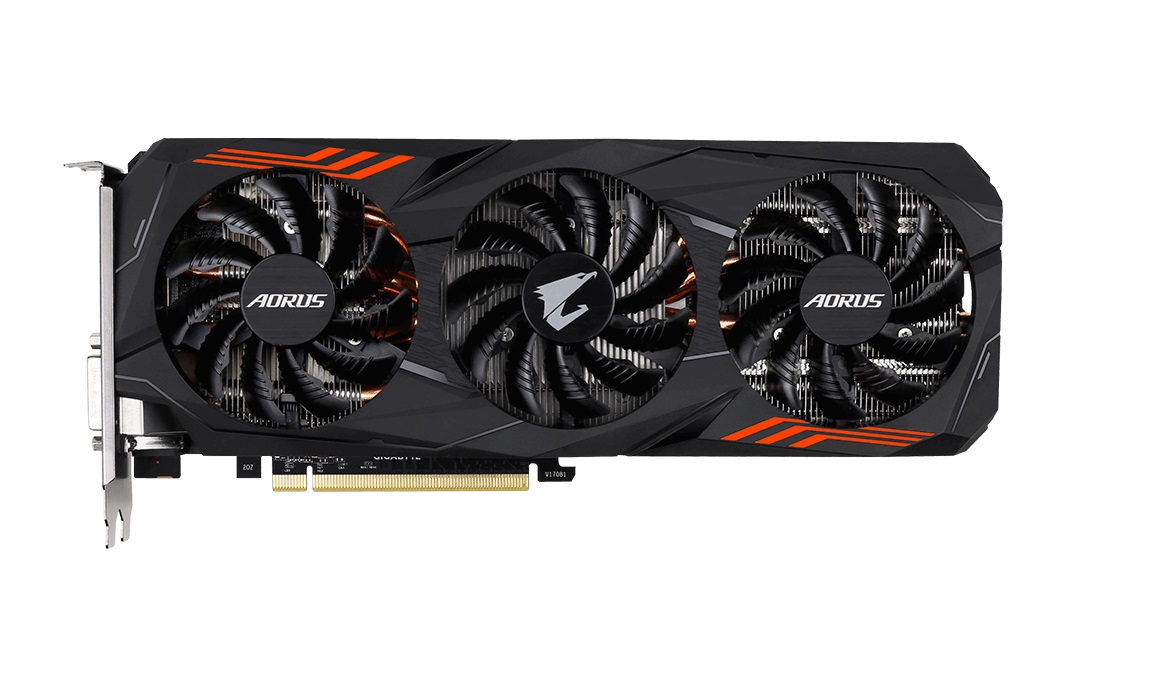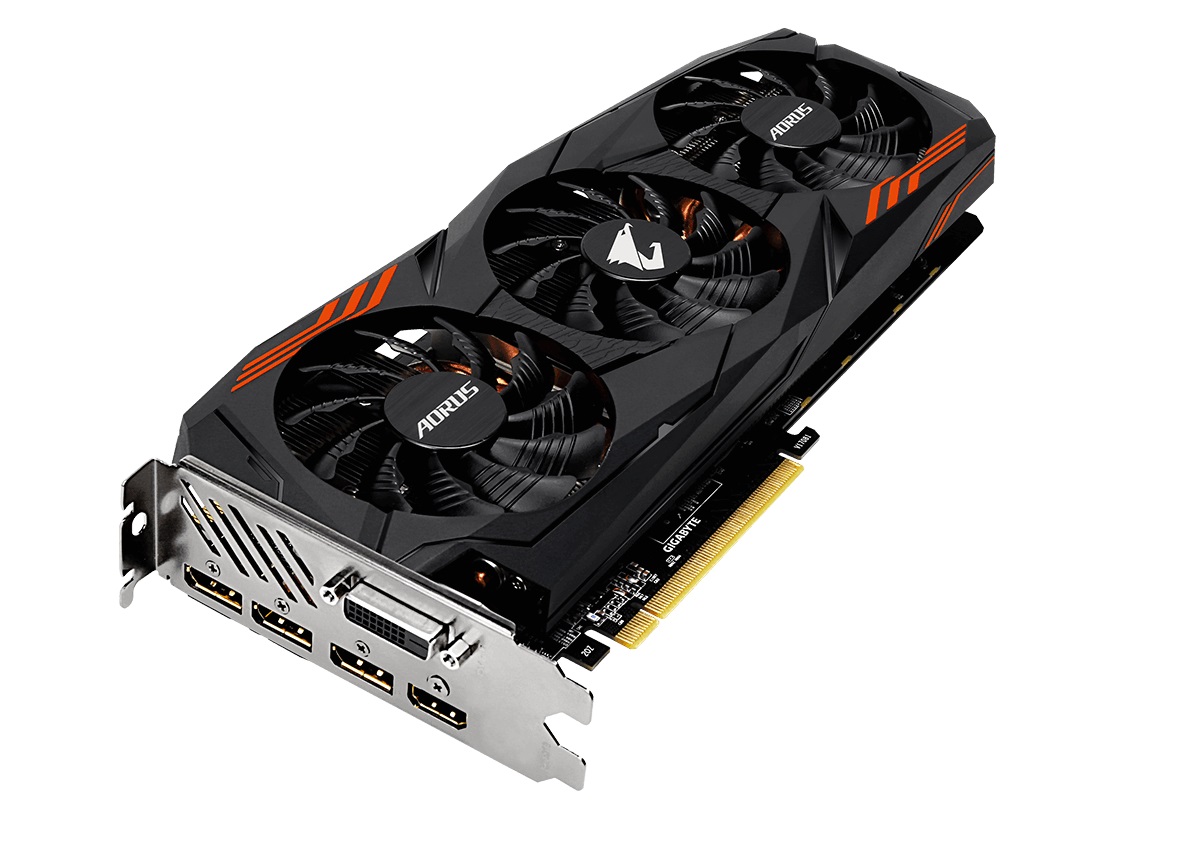Gigabyte Circumvents Nvidia’s Strict GTX 1070 Ti Clock Rates With New Aorus Card
Gigabyte announced a new Aorus-branded Nvidia GeForce GTX 1070 Ti graphics card featuring one-click overclocking.
The Gigabyte Aorus GeForce GTX 1070 Ti 8G takes form in a familiar Windforce 3X cooling shroud, with three specially-curved fans blowing air over aluminum fins that are connected with four copper heatpipes. The pipes make direct contact with the GPU and a large metal base plate that covers the VRAM modules via thermal pads, and the backplate also has a copper plate under the GPU for increased heat dissipation.
The new graphics card puts Gigabyte on a laundry list of vendors offering GTX 1070 Ti GPUs on custom PCBs. All of Nvidia’s partners were required to ship their respective GTX 1070 Ti cards with the reference base and boost clock rates (1,607MHz and 1,683MHz, respectively), making the cooling design (and a few brand-specific features) the only differentiation between all the GTX 1070 Ti graphics cards on the market. However, Gigabyte has found a way to circumvent Nvidia’s strict clockrate freeze for its new triple-fan Aorus GeForce GTX 1070 Ti 8G graphics card.
Similar to EVGA’s GTX 1070 Ti lineup, Gigabyte offers a one-click overclocking feature via software; its Aorus Graphics Engine Software automatically boosts the card’s clock rates to what the company would have liked to ship it with had Nvidia not restricted factory overclocks. Unlike EVGA’s automatic overclocking feature, which increases clockrates on a per-card basis with varying results, Gigabyte is guaranteeing its OC Mode base and boost clock frequencies of 1,683MHz and 1,771MHz (respectively) for every one of these new cards. Although this is not an aggressive overclock—it’s only an 88MHz boost clock increase—Gigabyte’s automatic OC feature is an easy and clever way to get around the restricted clock rates.
Like most GTX 1070 Ti graphics cards, the Gigabyte Aorus GeForce GTX 1070 Ti 8G sports a single 8-pin power connector and requires at least a 500W power supply. The display outputs are also standard, with a HDMI 2.0 port, three DisplayPort 1.4 interfaces, and a DVI-D port.
The new Gigabyte Aorus GeForce GTX 1070 Ti 8G graphics card should be arriving soon, but exact pricing and availability are currently unknown.
| Gigabyte Product | Aorus GeForce GTX 1070 Ti 8G |
|---|---|
| CUDA Cores | 2,432 |
| Base Clock | - 1,607MHz (Gaming Mode)- 1,683MHz (OC Mode) |
| Boost Clock | - 1,683MHz (Gaming Mode)- 1,771MHz (OC Mode) |
| Memory | 8GB 256-bit GDDR5 |
| Memory Clock | 8,008MHz |
| Display Output | - HDMI 2.0- DisplayPort 1.4 x3- DVI-D |
| Power Connectors | 8-pin |
| Recommended PSU | 500W |
Get Tom's Hardware's best news and in-depth reviews, straight to your inbox.
Derek Forrest was a contributing freelance writer for Tom's Hardware. He covered hardware news and reviews, focusing on gaming desktops and laptops.
-
TechyInAZ LOL, another reason why it made no sense for Nvidia to lock the GPUs for manufacturers, but keep it unlocked for consumers.Reply -
photonboy It's ANNOYING that you need to always run the software, because you might forget it's no longer running thus lose your overclock when you delete it for some reason. (normally you overclock the CARD through it's vBIOS so it stays with the card)...Reply
Another issue is the 8GHz effective memory. Compared to a GTX1080 you'll get a bigger swing in performance depending on what game you run, the resolution etc as the memory bandwidth matters (GTX1080 has 10GHz or 11GHz memory)... anywhere from almost PARITY to 10% slower on a GTX1070Ti vs GTX1080 of similar cooler and frequency...
I get that NVidia wanted to insert the GTX1070Ti in between the GTX1070 and GTX1080, and also that 8GHz was a (smart?) choice to reduce costs to the card manufacturers (which sell more cards so it in turn benefits NVidia) but just like the "3.5GB" GTX970 issue this seems like poor planning. Really, you didn't think people would object to this?
Keep in mind they ALREADY limit clock speeds via voltage caps if you did not know. I actually agree with that one as it is to keep QUALITY high (less failures) but I know some do not, and I certainly don't agree with this WEIRD solution which gets "fixed" by forcing someone to constantly run a software solution to apply the overclock. -
Pedasc I think there is a minor typo in the first paragraph. "one-clock overclocking" is probably supposed to be one-click overclocking like in the rest of the article I imagine.Reply -
ddferrari Reply
No, you don't need to run the software to maintain the OC. The software makes the changes in vBios. Once the OC is made, RGB lighting set, etc. the software can be closed and all settings are maintained.20449169 said:It's ANNOYING that you need to always run the software, because you might forget it's no longer running thus lose your overclock when you delete it for some reason. (normally you overclock the CARD through it's vBIOS so it stays with the card)...
Another issue is the 8GHz effective memory. Compared to a GTX1080 you'll get a bigger swing in performance depending on what game you run, the resolution etc as the memory bandwidth matters (GTX1080 has 10GHz or 11GHz memory)... anywhere from almost PARITY to 10% slower on a GTX1070Ti vs GTX1080 of similar cooler and frequency...
I get that NVidia wanted to insert the GTX1070Ti in between the GTX1070 and GTX1080, and also that 8GHz was a (smart?) choice to reduce costs to the card manufacturers (which sell more cards so it in turn benefits NVidia) but just like the "3.5GB" GTX970 issue this seems like poor planning. Really, you didn't think people would object to this?
Keep in mind they ALREADY limit clock speeds via voltage caps if you did not know. I actually agree with that one as it is to keep QUALITY high (less failures) but I know some do not, and I certainly don't agree with this WEIRD solution which gets "fixed" by forcing someone to constantly run a software solution to apply the overclock.
I speak from experience- I own an Aorus card and have confirmed this with GPU-Z. I use Afterburner now, but I originally started out with Gigabyte's software.

